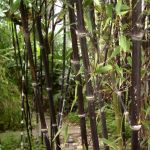| Common Name: |
Black Bamboo |
| Other Names: |
Kuro-chiku |
| Botanical Name: |
Phyllostachys nigra |
| Genus: |
Phyllostachys |
| Family: |
Poaceae |
| Cultivation: |
Moist, well-drained, rich soil in sun or dappled shade, with shelter from cold, drying winds. Remove dead stems at any time. Clumps may be thinned in spring to leave only the strongest stems. |
| Propagation: |
By division in spring during wet weather; by cuttings of young rhizomes in late winter. Divisions from open ground do not transplant well and should be nurtured in pots under cover until late spring. Small divisions are more successful than large clumps. |
| Harvest: |
Leaves are collected during the growing season, young stems are cut for shavings in summer, and roots are lifted in winter; all are dried for use in decoctions. Sap is pressed from young stems and evaporated. |
| Native Region: |
E and C China |
| Height: |
3-10m (10-30ft) |
| Width: |
Indefinite |
| Varieties: |
Boryana
Has green to yellow-green canes with purple-brown streaks. |
var. henonis
syn. Henonis
Has bright green stems that age yellow-green, and glossy foliage. |
|
| Hardiness: |
Z6-10 |
| Parts Used: |
Leaves, stem shavings, roots, sap |
| Properties: |
A sweet, cooling, diuretic and expectorant herb that lowers fever, controls vomiting, checks bleeding, and is effective against bacterial infections. |
| Medicinal Uses: |
Internally for lung infections with cough and phlegm (stem, sap); vomiting, nosebleed (leaves, stem); fevers especially infantile convulsions (leaves, roots); rabies (roots). |
| Bibliography: |
Encyclopedia of Herbs by Deni Brown Copyright © 1995, 2001 Dorling Kindersley Limited. pg 313.
|

